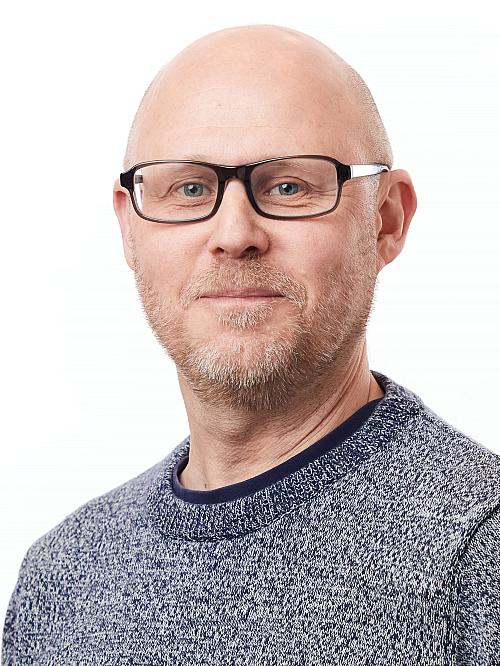Frequently asked questions about copyright for teachers
All literary and artistic works are protected by copyright law. As a teacher, you therefore need to be aware of how you may use texts and other material from books and articles, such as pictures, tables, figures and even musical notes in your teaching.
Through the Bonus Copyright Access agreement to which JU is connected, you can use such material without having to ask permission from the copyright holder. However, there are restrictions on how much you can use and to what extent.
What can I copy and share in my teaching?
Like virtually all Swedish colleges and universities, Jönköping University has an agreement with the copyright organization Bonus Copyright Access. The agreement allows you as a teacher the right to, to a certain extent, copy and share copyright-protected Swedish and foreign material. This is what you can do when it comes to copying and sharing in your teaching:
- Printed version: You may copy, scan and share a maximum of 15%, but no more than 15 pages, of a printed publication. This is called the 15/15 rule.
- Digital edition: You may download, print and share a maximum of 15 A4 pages.
- However, it is permitted to copy up to three additional pages if necessary to make a chapter, section or article complete.
- Number of copies: A maximum of so many copies that the students each get one and that you as the teacher get a few.
- As a teacher, you get to make a hard copy of an entire book for yourself. But you may not scan or save in digital form an entire book.
- The student group must always be limited to the university.
- Sound recordings and moving images are not covered by the agreement.
- It is good to cite the source in connection with what you use in your teaching!
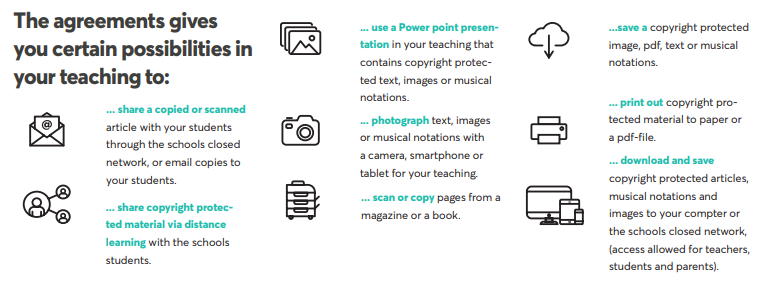
Can I share copyrighted material via Canvas?
Through the Bonus Copyright Access agreement, it is permitted to upload and share copyrighted material via a closed network such as the Canvas learning platform. The same rules regarding scope of what you are allowed to share apply as in the question above.
Can students share material from Canvas?
Any material made available on Canvas, including presentations, articles, practice exams, and compendiums, should not be shared outside of the Canvas platform.
While students are permitted to make a copy of a presentation for their personal use, they do not have the right to distribute the material to others or make it available on digital platforms on the Internet or in social media.
The agreement with Bonus Copyright Access states that you may only share copyrighted material in the network and in the digital platform (Canvas) that both students and teachers use. No other distribution is permitted.
Can I share copyrighted material via email?
Through the Bonus Copyright Access agreement, it is permitted to share copyrighted material via e-mail within a teaching group limited to the institution, including distance courses at the university. The same rules regarding scope of what you are allowed to share apply as in the question above.
Can I copy and share publisher-produced compulsory course literature?
Publisher-produced compulsory course literature is such literature that the student must use in a course or before an exam. The main rule is that this is not allowed, except in three cases:
- If you only want to use a small section from the course literature that does not exceed 15%, but no more than 15 pages (the 15/15 rule).
- Individual sections may be copied to insert into a PowerPoint presentation or similar. The presentation may only be used in a teaching context within the institution (including distance learning in a course at the university).
- Individual sections may be copied for an examination assignment.
Can I use images from copyrighted material in PowerPoint presentations?
Yes, with the Bonus Copyright Access agreement, it is permitted to use copyrighted material in PowerPoint presentations or similar under these conditions:
- As long as it takes place in a teaching context within the institution (including distance learning in a course at the university) or shared via Canvas.
- You should indicate the source you obtained the text or image(s) from.
Where can I find free images?
There are a number of image services that have free images with a Creative Commons license that allows you to use them without having to seek permission.
Here is a small selection of sites with free images:
- Flickr
Free images and videos with the possibility to choose different types of Creative Commons licenses. - Smithsonian Open Access
Images of objects from the Smithsonian's more than 20 museums and research centers, archives and libraries. - Unsplash
Millions of free photos. Unsplash has their own license which is similar to Creative Commons. - The 34 best sites for free images and pictures
A website with an annotated list of 34 sites for free images.
NB! Don't forget to indicate the source you got the images from!
Can I use YouTube videos or audio recordings in my teaching?
The Bonus Copyright Access agreement does not cover films and sound recordings, so in that case you must contact the author or the organization that produced it. However, just as with texts and images, there may be free material with a Creative Commons license:
Videos
- Some YouTube videos may have a Creative Commons license which means you can use it according to the license without having to ask permission from the creator. See "How to find Creative Commons materials using YouTube".
- However, it is allowed to embed YouTube videos, even those without any Creative Commons license as it is considered as a linking.
Audio recordings/music
According to § 21 Act (1960:729) on copyright to literary and artistic works (Swedish legislation), you may perform a work publicly in connection with teaching as long as it is in a non-commercial context.
- If you yourself want to perform a piece of music in your teaching, you can do so without seeking permission.
Can I play music from Spotify in my teaching?
The Bonus Copyright Access agreement does not cover music, so you therefore have to follow the copyright rules that Spotify or similar services have. They generally don't allow you to use the service for anything other than private and non-commercial purposes.
According to § 21 Act (1960:729) on copyright to literary and artistic works (Swedish legislation), you may perform a work publicly in connection with teaching as long as it is in a non-commercial context. Seen from this perspective, you could play music from Spotify and similar services in your teaching.
It remains unclear whether the services' contractual terms can override the exemption rules found in the legislation to promote education.
Am I allowed to perform someone else's piece of music in my teaching?
The Bonus Copyright Access agreement does not cover music, but according to § 21 Act (1960:729) on copyright to literary and artistic works (Swedish legislation), you may perform a work publicly in connection with teaching as long as it is in a non-commercial context.
The copyright to a work applies during the lifetime of the author and for 70 years after the end of the year of the creator's death. Copyright for works that have been created by two or more authors jointly is calculated from the end of the year of death of the last deceased creator.
What do I do if I want to use material outside of the Bonus Copyright Access agreement?
If you want to copy and share more, or in other ways, than what is permitted in the Bonus Copyright Access agreement, you must obtain permission from the copyright holder.
- Contact the publisher for published material.
- If it concerns large amounts of text or images located on a website, contact the person or organization behind the website.
When making such a request, you should state what you want to copy and make available, the purpose of the use, how much and how you want to share the material, for example in physical or digital form.
Bonus Copyright Access has sample documents for these purposes that you can use as a template for inquiries. See "Application for permission to copy" under the heading "Kopiering utöver avtalet".
How do I find open educational resources that I can use in my teaching?
Open Educational Resources (OER) are digital teaching materials that you can freely reuse and process in your own teaching. It can be anything that you can use in your teaching and covers things like images, YouTube videos, presentation materials, film clips, books, study guides, podcasts, and other resources like multiple choice questions etc. The definition also includes that they must have a Creative Commons license, or similar, which allows free use and free distribution. You can also share learning resources you have created yourself. For a more detailed definition, see "Accessible Open Educational Resources (OER): briefing paper" from UNESCO.
Where to find open educational resources?
- Creative Commons – OER
Creative Commons has collected a large number of websites to find free resources. The list is divided by: General search, photos/images, videos, audio/music, open educational resources, recorded lectures and video tutorials, books, simulation and animation, course modules and full courses. - OER Commons
A digital library with tens of thousands of open educational resources such as entire courses, lesson materials, multiple choice questions, etc. - OpenLearn Create
Search for educational materials published through The Open University. You can also search for open educational resources from other universities via the "Universal search of other OER sites" search function. - Canvas Commons
Canvas has a feature called Canvas Commons where you can search for different types of learning resources in different languages. There you will find images, videos, courses, ready-made modules and multiple-choice questions (quizzes).
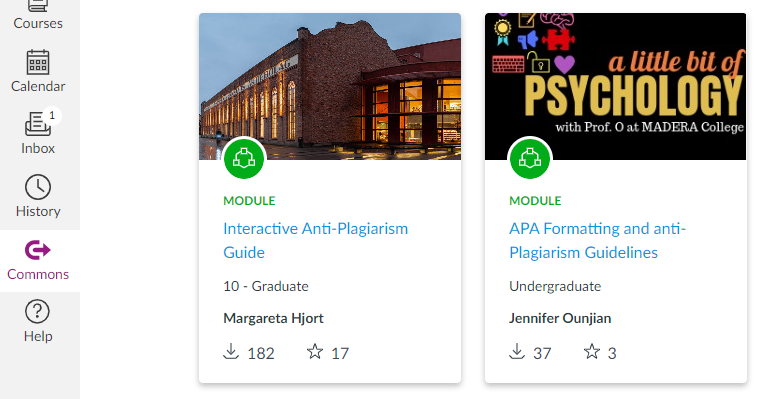
As the supply of open learning resources is constantly increasing, it is good that you also reflect on your choice of resources.
What is Creative Commons?
Creative Commons is a non-profit organization that has created a system of licenses to help those who want to share their works or who want to distribute their book or article freely. If you mark your works with a Creative Commons license, you specify the ways in which others may use the work without having to apply for permission from you or the publisher as the copyright holder. You can mark things like journal articles, books, chapters, articles on web pages, images and photos, PowerPoint presentations and YouTube clips, but also things like research data and learning resources.
CC licenses are based on four terms and these can be expressed either graphically with symbols or written with abbreviations:
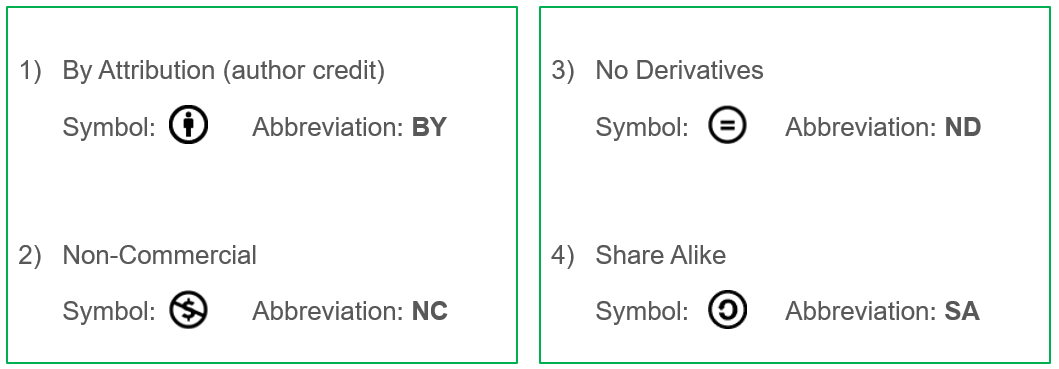
These can then be combined in six different ways:
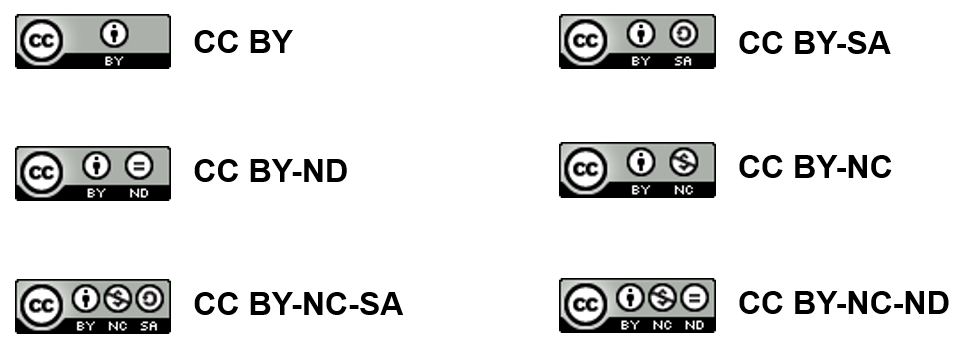
In addition, there are also two different symbols that indicate that a work is completely free.
- CC0 (CC zero) means that the author has waived all rights and you can use the work or image as you wish. The work has therefore become part of the public domain.
- The second symbol, the Public Domain Mark (PDM), is not really a license but a marking of material that has been identified as completely free and that is already in the public domain.
These concepts are not completely simple and if you want to read more about them, you can start here.

What about images in student theses?
As a teacher, you may get questions from students about whether they can use copyrighted images, tables and other figures in their essays. You can then refer them to or get information about this yourself on the page for students: Frequently asked questions about copyright for students.
How much text can I quote?
You have the right to quote parts of a work in accordance with good practice and to the extent justified by the purpose without the permission of the copyright holder according to the right of quotation. There must therefore be a need to include parts of someone else's work in your own text. If you are going to review a text critically or want to highlight your reasoning or interpretations of a work, it may be justified to quote parts of the text in your article. How much you can cite varies from case to case, but in scientific contexts it can be quite large parts depending on the context. However, you may not quote an entire work.
Please note that this citation right only applies to text, not images!
What is meant by good practice?
Good practice means that you indicate the reference to the source and do not quote unnecessarily. The quotation should serve to elucidate, provide context, or otherwise bolster one’s own work.


